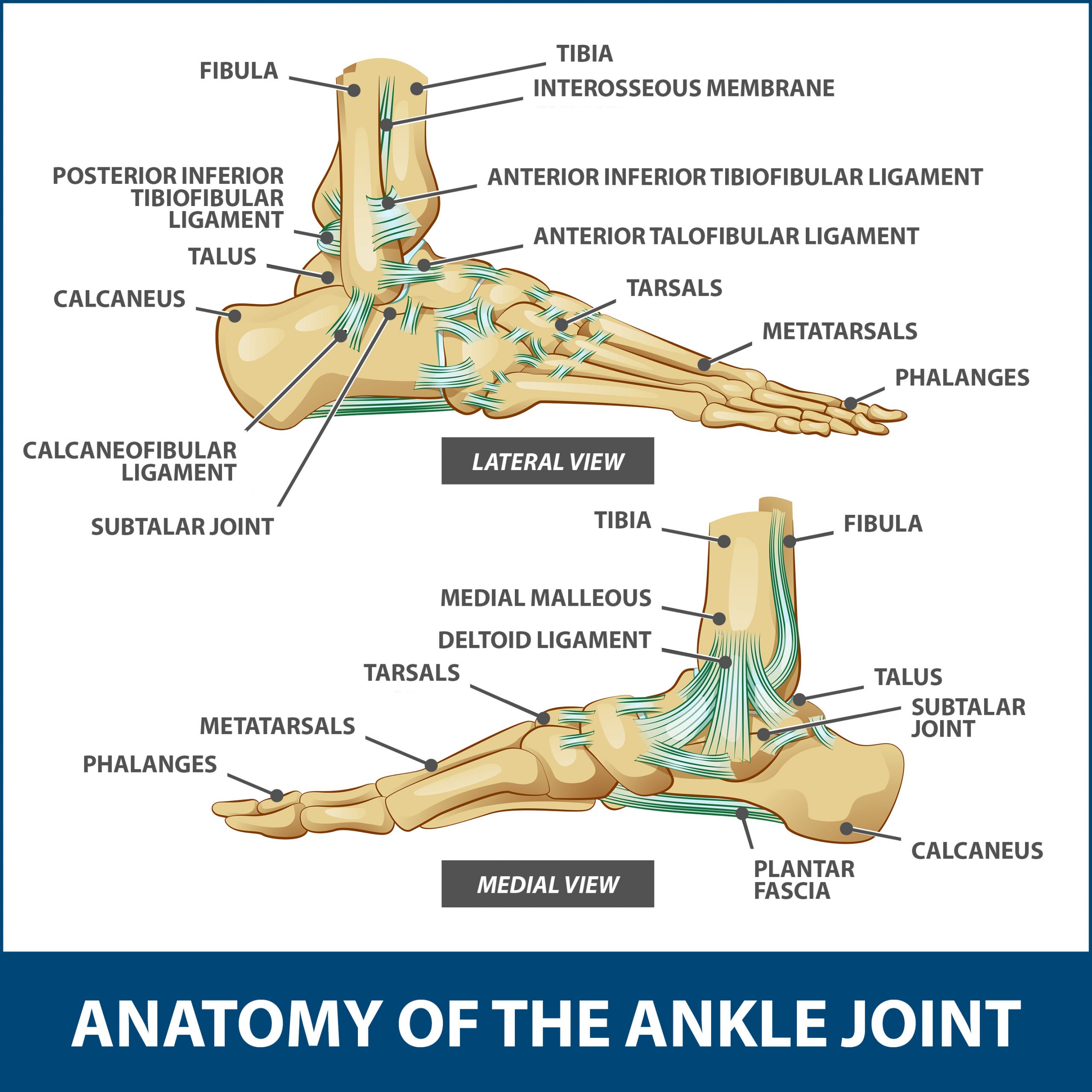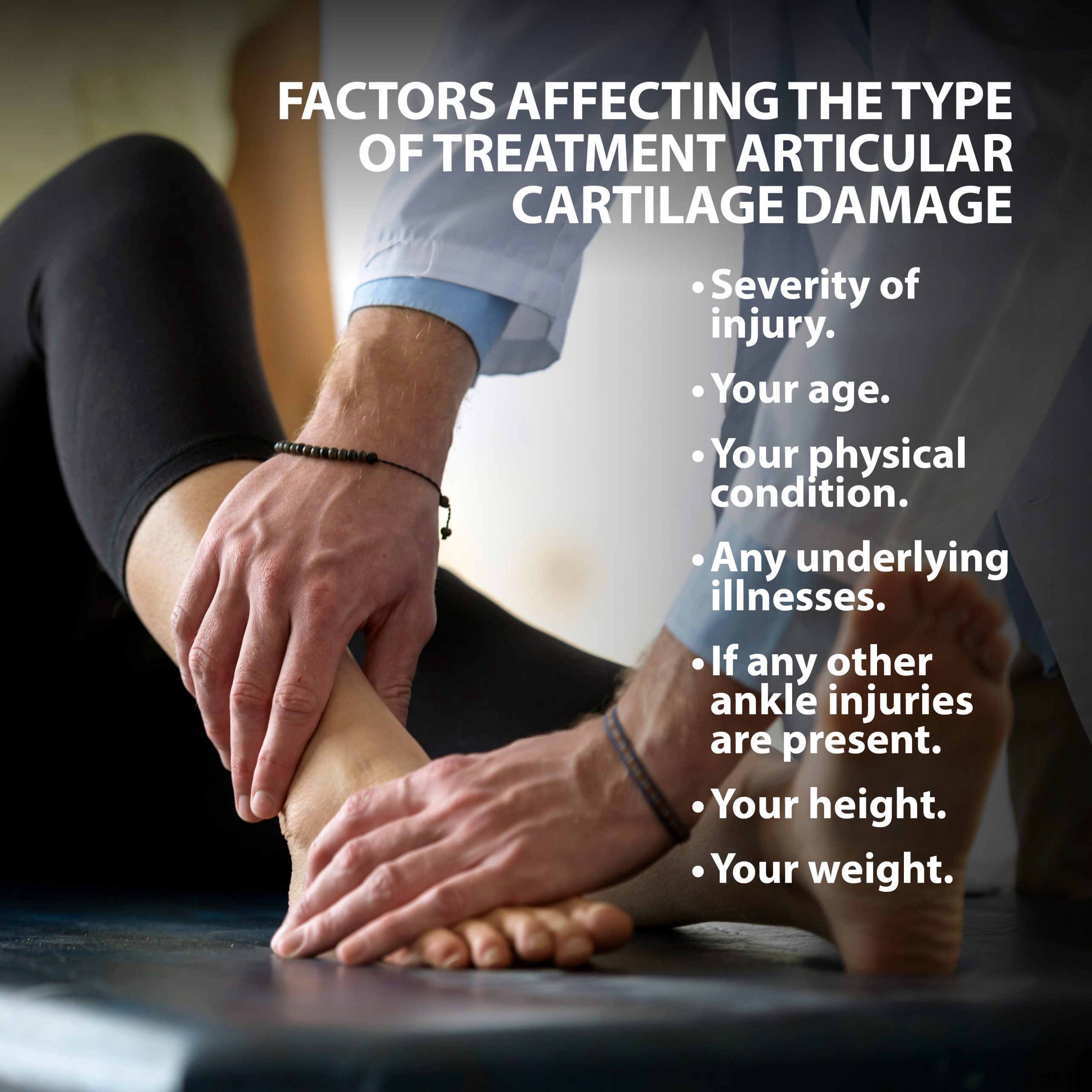ARTHROSCOPIC ARTICULAR CARTILAGE REPAIR
Overview
Your ankles are extremely important. They enable you to move your feet and perform activities such as walking, running, standing, jumping, and turning your legs.
The ankles are strong and capable of handling a significant amount of wear. However, constantly bearing the body’s weight, in addition to events like age, overuse, traumatic accidents, or participation in competitive athletics, can quickly or gradually result in weakening and the development of various physical conditions. One such condition is articular cartilage damage.
Anatomy
Articular cartilage is a soft tissue protecting the parts of bones where they fit into joints. The ankle is one of the body’s major joints and connects three important structures: the leg bones (known as the tibia and fibula) and the foot bone (the talus).
Cartilage serves several functions. It protects bones from injury and also prevents joint friction.

Description
Articular cartilage damage can cause discomfort and disrupt the normal operation and movement of surrounding bones, muscles, and other soft tissues.
Causes For Cartilage Deterioration
Several underlying factors can contribute to articular cartilage damage.
The most notable cause is age. Cartilage tends to weaken and deteriorate as you age. Furthermore, this problem is often worsened because articular cartilage has limited or no blood supply, which is necessary for the healing process. Damaged articular cartilage cannot repair itself.
Another notable cause is traumatic injury. A sudden fall or car accident can result in immediate and direct cartilage injury.
Other moderate to severe ankle injuries can also result in cartilage damage. Doctors often discover articular cartilage issues when diagnosing other problems, including dislocations, bone breakages, and ligament sprains.
Risk Factors
Naturally, your risk of developing age-related cartilage deterioration is greater if you are older. If you compete in competitive contact sports, participate in activities placing significant pressure on your feet, or work in a profession requiring you to stand or continually turn your legs and feet, your chances increase.
Symptoms
The symptoms you feel may vary depending on how bad your injury is. That said, common occurrences include:
- Ankle stiffness.
- Pain.
- Redness.
- Tenderness.
- Swelling.
- A popping or clicking sensation coming from your affected ankle.

These symptoms might intensify when you stand, place weight on your ankle or you engage in any type of movement. Additionally, in more serious cases, your joint may lock, which could limit your mobility. You could also experience instability or the feeling that your ankle is about to give out.
Complications
If left untreated, articular cartilage damage will likely worsen, leading to more intense pain, mobility problems, and other related symptoms. Furthermore, as cartilage gradually weakens, your ankle bones receive less and less protection. Such events can place these physical structures at an increased risk of fractures and ailments like osteoarthritis.
Diagnosis
Your physician will likely first request that you undergo a weight-bearing X-ray. This means that you will stand when the X-ray is taken. This scan enables your doctor to view the ankle’s internal structural condition.
You may need more advanced imaging devices like magnetic resonance imaging (M.R.I. scans). Articular cartilage is also referred to as hyaline cartilage. Unfortunately, this type of material does not contain calcium, occasionally making injuries more challenging to identify on X-rays.
Treatment Overview
Orthopedic doctors typically place articular cartilage injuries into categories ranging in severity from one to four, using the Outerbridge classification of cartilage damage. These grades are based on the appearance of the articular cartilage when seen at arthroscopy.
Grade 0 – Normal cartilage
Grade 1 – Cartilage softening and swelling
Grade 2 – Partial-thickness loss with fissures on the surface that do not reach subchondral bone or exceed 1.5 cm in diameter
Grade 3 – Fissuring to the level of subchondral bone in an area with a diameter more than 1.5 cm
Grade 4 – Exposed subchondral bone
Treatment may not always need surgery. Naturally, less severe damage will likely need less aggressive therapy.
Other factors may play into the type of treatment you receive, such as:
- Your age.
- Your physical condition.
- If you have any underlying illnesses.
- If any other ankle injuries are present.
- Your height.
- Your weight.

Often athletes will undergo more advanced treatment geared towards helping them begin the recovery process quicker.
Non-Surgical Options
In uncomplicated, mild cases, simple home remedies can produce improvement. One commonly used therapeutic effort is called the RICE technique.
R.I.C.E. is short for Resting the injured ankle, applying Ice to the injured area, Compressing the ankle to prevent the joint from exposure or further injury, and keeping the structure Elevated.
Additional non-surgical therapies might include placing your ankle inside a cast to prevent unnecessary movement and the use of over-the-counter or prescription pain-relieving or anti-inflammatory medications.
Surgical Interventions
Mild to moderate occurrences are often corrected using arthroscopic articular cartilage repair.
Surgeons perform this procedure by inserting a small camera-operated device called an arthroscope into your ankle. The pictures generated from the arthroscope enable the surgeon to remove or repair damaged cartilage using tiny instruments.
Doctors prefer using arthroscopic repair because it is considered minimally invasive. This means the operation does not need large incisions or lead to significant scarring after the procedure is completed.
More serious cases may need more aggressive procedures like microfracture surgery and cartilage transplantation.
Following an operation, you will likely be required to remain off your ankle for at least a month or more. As your ankle gradually heals, you will need to undergo physical therapy – a collection of exercises designed to help your ankle regain strength and mobility.
Next Steps
If you have been diagnosed with articular cartilage damage or are experiencing the symptoms of this condition, the team of ankle specialists at Florida Orthopaedic Institute can help. Contact your physician to learn more about Arthroscopic Articular Cartilage Repair.
Areas of Focus
- Foot, Ankle & Lower Leg
- Achilles Tendinitis - Achilles Insertional Calcific Tendinopathy (ACIT)
- Achilles Tendon Rupture
- Achilles Tendonitis
- Ankle Fracture Surgery
- Ankle Fractures (Broken Ankle)
- Ankle Fusion Surgery
- Arthroscopic Articular Cartilage Repair
- Arthroscopy Of the Ankle
- Bunions
- Charcot Joint
- Common Foot Fractures in Athletes
- Foot Stress Fractures
- Hallux Rigidus Surgery - Cheilectomy
- Hammer Toe
- High Ankle Sprain (Syndesmosis Ligament Injury)
- Intraarticular Calcaneal Fracture
- Lisfranc Injuries
- Mallet, Hammer & Claw Toes
- Metatarsalgia
- Morton’s Neuroma
- Neuromas (Foot)
- Orthopedic Physician Or A Podiatrist? Definition of a Podiatrist
- Plantar Fasciitis
- Sports Foot Injuries
- Sprained Ankle
- Total Ankle Replacement
- Turf Toe
The following Florida Orthopaedic Institute physicians specialize in Arthroscopic Articular Cartilage Repair:
Specialties
- AC Joint Injuries
- Achilles Tendinitis - Achilles Insertional Calcific Tendinopathy (ACIT)
- Achilles Tendon Rupture
- Achilles Tendonitis
- ACL Injuries
- Ankle Fracture Surgery
- Ankle Fractures (Broken Ankle)
- Ankle Fusion Surgery
- Anterior Cervical Corpectomy & Discectomy
- Arthroscopic Articular Cartilage Repair
- Arthroscopic Chondroplasty
- Arthroscopic Debridement of the Elbow
- Arthroscopy Of the Ankle
- Articular Cartilage Restoration
- Artificial Disk Replacement (ADR)
- Aspiration of the Olecranon Bursa - Fluid In Elbow
- Atraumatic Shoulder Instability
- Avascular Necrosis (Osteonecrosis)
- Bankart Repair
- Basal Joint Surgery
- Bicep Tendon Tear
- Bicep Tenodesis
- Bone Cement Injection
- Bone Growth Stimulation
- Bone Health Clinic
- Broken Collarbone
- Bunions
- Bursitis of the Shoulder (Subacromial Bursitis)
- Calcific Tendinitis of the Shoulder
- Carpal Tunnel Syndrome
- Charcot Joint
- Chiropractic
- Clavicle Fractures
- Colles’ Fractures (Broken Wrist)
- Common Foot Fractures in Athletes
- Community Outreach
- Cubital Tunnel Syndrome
- De Quervain's Tenosynovitis
- Deep Thigh Bruising
- Degenerative Disk Disease
- Diffuse Idiopathic Skeletal Hyperostosis (DISH)
- Discectomy
- Discitis Treatment & Information
- Dislocated Shoulder
- Dupuytren’s Disease
- Elbow
- Elbow Bursitis
- Elbow Injuries & Inner Elbow Pain in Throwing Athletes
- Epidural Injections for Spinal Pain
- Finger Dislocation
- Flexor Tendonitis
- Foot Stress Fractures
- Foot, Ankle & Lower Leg
- Foraminotomy
- Fractured Fingers
- Fractures Of The Shoulder Blade (Scapula)
- Fractures Of The Tibial Spine
- Functional Nerve Transfers of The Hand
- Ganglion Cysts
- General Orthopedics
- Glenoid Labrum Tear
- Golfer's Elbow
- Groin Strains and Pulls
- Growth Plate Injuries Of The Elbow
- Hallux Rigidus Surgery - Cheilectomy
- Hammer Toe
- Hamstring Injuries
- Hand & Finger Replantation
- Hand & Wrist
- Hand Nerve Decompression
- Hand Skin Grafts
- Hand, Wrist, Elbow & Shoulder
- Heat Injury/Heat Prostration
- High Ankle Sprain (Syndesmosis Ligament Injury)
- Hip & Thigh
- Hip Arthroscopy
- Hip Dislocation
- Hip Flexor Strains
- Hip Fractures
- Hip Hemiarthroplasty
- Hip Impingement Labral Tears
- Hip Muscle Strains
- Hip Pointers and Trochanteric Bursitis
- Hyperextension Injury of the Elbow
- Iliopsoas Tenotomy
- Iliotibial Band Syndrome
- Impingement Syndrome of the Shoulder
- Interlaminar Implants
- Interlaminar Lumbar Instrumental Fusion: ILIF
- Interventional Pain Management
- Interventional Spine
- Intraarticular Calcaneal Fracture
- Joint Replacement
- Knee & Leg
- Kyphoplasty (Balloon Vertebroplasty)
- Kyphosis
- Labral Tears Of The Hip (Acetabular Labrum Tears)
- Laminectomy: Decompression Surgery
- Lateral Collateral Ligament (LCL) Injuries
- Lisfranc Injuries
- Little League Shoulder
- LITTLE LEAGUER'S ELBOW (MEDIAL APOPHYSITIS)
- Lumbar Epidural Steroid Injection
- Lumbar Interbody Fusion (IBF)
- MACI
- Mallet, Hammer & Claw Toes
- Medial Collateral Ligament Injuries
- Meniscus Tears
- Metatarsalgia
- Minimally Invasive Spine Surgery
- Morton’s Neuroma
- Muscle Spasms
- Muscle Strains of The Calf
- Nerve Pain
- Neuromas (Foot)
- Neurosurgery
- Olecranon Stress Fractures
- Orthopaedic Total Wellness
- Orthopaedic Trauma
- Orthopedic Physician Or A Podiatrist? Definition of a Podiatrist
- Osteoarthritis of the Hip
- Osteoporosis
- Outpatient Spine Surgery
- Partial Knee Replacement
- Patellar Fracture
- Pelvic Ring Fractures
- Peripheral Nerve Surgery (Hand) Revision
- Pinched Nerve
- Piriformis Syndrome
- Piriformis Syndrome
- Plantar Fasciitis
- Plastic Surgery
- Podiatry
- Primary Care Sports Medicine
- Quadriceps Tendon Tear
- Radial Tunnel Syndrome (Entrapment of the Radial Nerve)
- Revascularization of the Hand
- Reverse Total Shoulder Replacement
- Rheumatoid Arthritis (RA) of the Shoulder
- Rheumatoid Arthritis Of The Hand
- Robotics
- Rotator Cuff Tears
- Runner's Knee
- Sacroiliac Joint Pain
- Sciatica
- Scoliosis
- Senior Strong
- Shin Splints
- Shoulder
- Shoulder Arthritis
- Shoulder Arthroscopy
- Shoulder Injury: Pain In The Overhead Athlete
- Shoulder Replacement
- Shoulder Separations
- Shoulder Socket Fracture (Glenoid Fracture)
- SLAP Tears & Repairs
- Spinal Fusion
- Spine
- Spondylolisthesis and Spondylolysis
- Sports Foot Injuries
- Sports Hernias (Athletic Pubalgia)
- Sports Medicine
- Sports Wrist and Hand Injuries
- Sprained Ankle
- Sprained Wrist Symptoms and Treatment
- Subacromial Decompression
- Sudden (Acute) Finger, Hand & Wrist Injuries
- Targeted Muscle Reinnervation (TMR)
- Tendon Transfers of The Hand
- Tennis Elbow Treatment
- Thigh Fractures
- Thigh Muscle Strains
- Thumb Ulnar Collateral Ligament Injuries
- Total Ankle Replacement
- Total Hip Arthroplasty
- Total Hip Replacement - Anterior Approach
- Total Knee Replacement Surgery
- Trapezius Strain (Muscle Strain of The Upper Back)
- Traumatic Shoulder Instability
- Tricep Pain & Tendonitis
- Trigger Finger
- Turf Toe
- UCL (Ulnar Collateral Ligament) Injuries
- Ulnar Neuritis
- Valgus Extension Overload
- Vertebroplasty
- WALANT (Wide Awake Local Anesthesia No Tourniquet)
- Whiplash and Whiplash Associated Disorder (WAD)
- Wound Care
- Wrist Arthroscopy
- Wrist Fractures
- Wrist Tendonitis
Services
- Physical Medicine & Rehabilitation
- Physical Therapy
- Primary Care Sports Medicine
- PROMs (Patient-Reported Outcome Measures)
- Same-Day Orthopaedic Appointments Now Available
- Sports Medicine
- Sports-Related Concussion Treatment
- Telehealth Page
- Telemedicine
- Workers' Compensation
- Workers' Compensation Dispensary
- X-Ray
